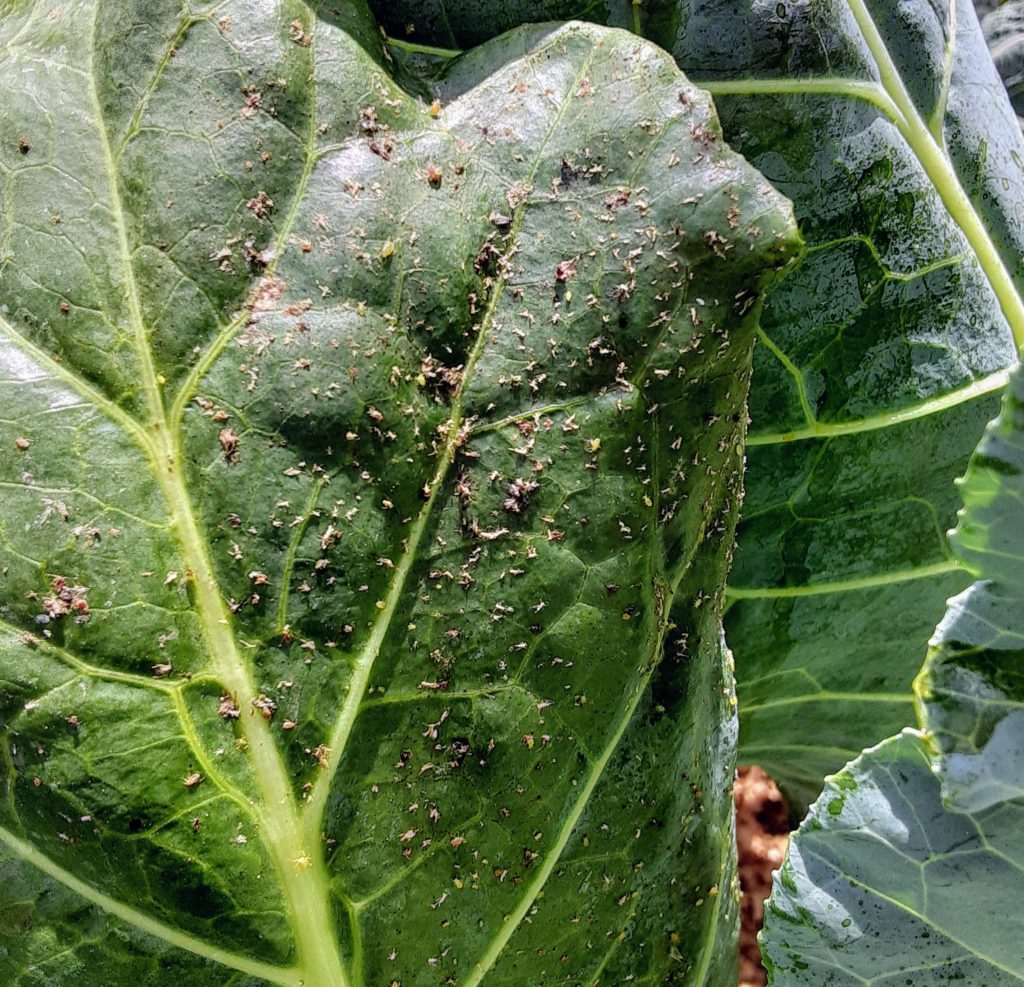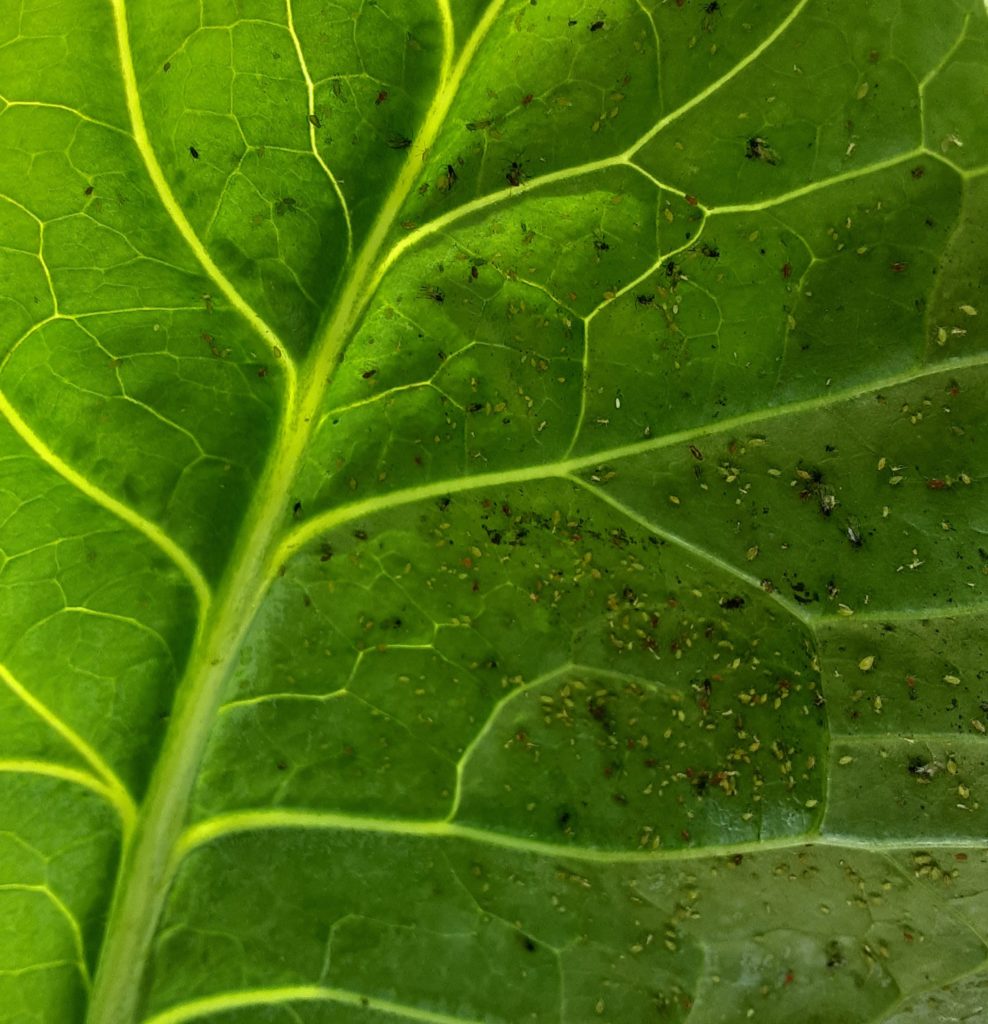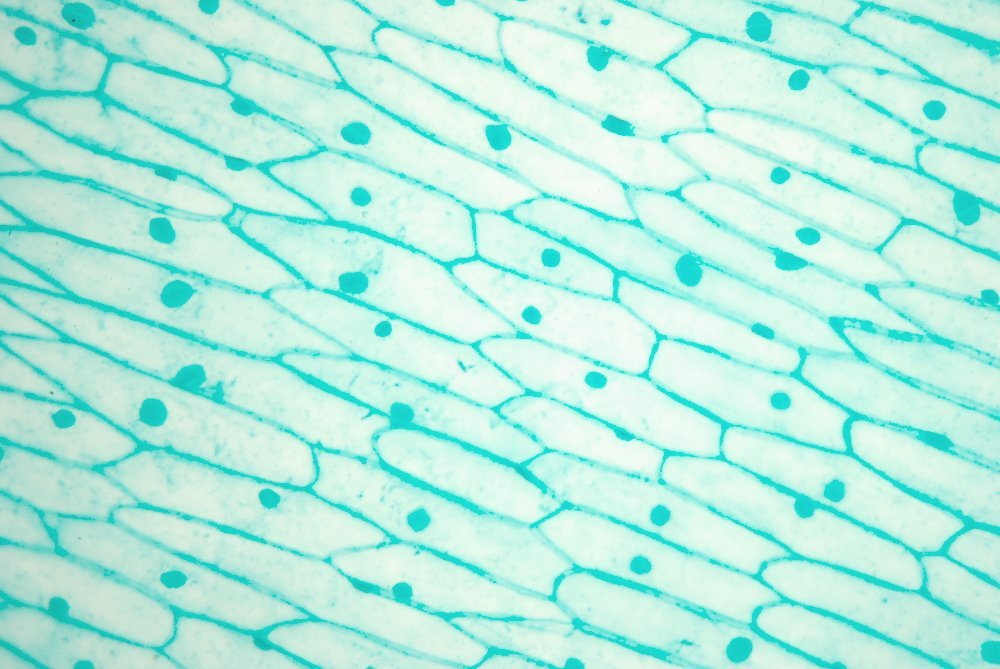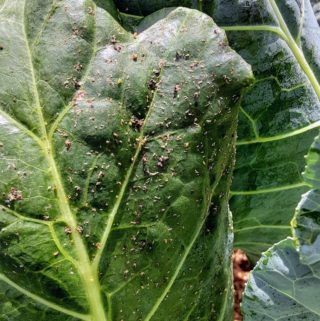
After you’ve spent all spring working on growing your baby plants from seeds, then planting those starters in the garden, and watching them grow big through the summer, the last thing you want to see is your harvest being shared with garden pests that enjoy that garden just as much as you do.
Aphids, hornworms, slugs, grasshoppers, and more can cause so much damage to your garden that it starts to feel that you’re just watering the plants to keep them alive for the pests to eat them.
This year, I’ve been battling aphids and grasshoppers. They’ve infested one of my garden beds (“Red the Garden Bed” is her name) so bad that I almost wanted to pull all of the plants out and start over. Alas, I wasn’t giving up that easy. I started researching organic pest sprays and ways to get rid of them without having to spray insecticides on the plants that we would later be eating.
I asked my Facebook gardening group for recommendations and fellow, local gardeners what they recommended. I know that other areas of the country would likely have recommendations too, but I wanted to make sure that the option I went with also would work for my high country garden.
The most recommended form of treatment was a garlic spray that was organic, yet safe for humans and animals, and come to find out it was a pest control spray that was used in gardens everywhere.
What Pests Does the Garlic Spray Repel?

The good news is that the garlic spray helps with LOTS more than just aphids and grasshoppers. I’m sure this list isn’t inclusive, but from what I gathered, here’s a list of pests the spray helps repel.
- Aphids
- Ants
- Beetles
- Blackflys
- Borers
- Grasshoppers
- Mosquitos
- Red Spider Mites
- Slugs
The spray also helps fight off powdery mildew while deterring larger animals like mice, vols, deer, and rabbits.
Be warned, however, the spray repels the friends of your garden too, like ladybugs and caterpillars. I read from one gardener that she only sprays twice a season and is able to keep the foe pests away and maintain happy friends like bees and ladybugs.
Another tip is to only spray the areas where pests are an issue; leaving other areas untouched by the spray to invite the beneficial bugs to still come and do the work your garden needs for it to thrive.
This post may have affiliate links, which means I may receive commissions if you choose to purchase through links I provide (at no extra cost to you). Thank you for supporting the work I put into this site!
How Does Garlic Fight Garden Pests?
There are many health benefits of garlic for humans and plants, and it’s quite magical what happens when you slice a garlic glove in half.
Each garlic clove has sulfur compounds called alliin that is divide by cells. When a clove is cut, alliin compounds combine with the enzyme alliinase and allicin is formed, which is where the magic starts.

Allicin is what gives the clove its unique smell, taste, and health benefits. It’s the stuff that makes your eyes tear up when cutting garlic and onions. It’s also the stuff that offers natural antibacterial, antifungal, and insect-repellent properties. Humans and plants benefit from allicin, but pests and mildew are repelled by it. To learn more about the science of garlic, take a look at this Garlic Gold article.
Allicin stops its chemical process after a few days, which means the garlic spray should be used within the first week of making it.
Recipe Tips
The full recipe is below, but I did wanted to add a few pointers that I’ve learned to help with the process.
- Don’t worry about peeling the garlic cloves. The whole clove can be put into the food processor and ground up with the rest of the ingredients. You’ll be filtering the spray anyway, so no need to waste time on peeling all of the garlic.
- You can stick with just using garlic and water, but when you add a few additional ingredients the garlic spray starts to really pack a punch.
- Dish Soap or Vegetable Oil
- Kelp (works as an organic miracle grow for your plants – use on indoor house plants too; read the reviews in that link to learn more)
- Mint
- Neem Oil
- Hot Pepper Sauce or Cayenne
- Some of these ingredients, like dish soap and hot pepper sauce, do work to harm/kill pests, so please do further research if that is a concern to you.
- The recipe below includes adding cayenne which basically creates a pepper spray. It’s not as powerful as bear spray, but if it gets in your eyes it will likely burn. Take precautions.
- Use garlic spray in the morning, evening, or a cloudy day to prevent from burning the plants.
- Wait a day or two after your last garlic spray to harvest plants. Some lighter plants like lettuce may take on the garlic and kelp taste and it is recommened to wait a week after spraying to harvest.
- Before eating plants, WASH them very well. For hardier plants like collards and kale, I usually soak them in a clean sink in cold water and kosher salt. The salt helps remove debris and pests that happen to not been repelled. Drain the water and rinse again.
- Store any unused spray in the refrigerator to keep it preserved, but try to use spray within the first 2 days (see allicin comment above).
How to Use Garlic Spray in the Garden

You could use any bottle sprayer, but I have been using one like this for a couple of seasons and find that it gets the job done. After you make the spray and let it sit overnight, filter it with a cheesecloth and fine-mesh strainer, and funnel the slurry into a garden bottle sprayer.
Use the spray on any plants that need to deter pests including flowers, fruits, vegetables, and herbs. Use the spray once a week to once a month making sure to spray the top and bottom of leaves, which is where larvae and eggs are usually hiding. Watering the top of the plants will wash the garlic spray away, which will invite pests back, but we’re trying to find a fine balance of welcoming the good bugs and keeping out the bad bugs.
With that said, it’s best to spray only the parts of the plant you are having issues with so that the friendly bugs can find their way to the parts not sprayed. After the plants get wet from watering or rain, check the garden mid-week and make sure an infestation isn’t starting between your garlic spray treatments.
Ideally, a drip irrigation system is installed in your garden to help with watering from below instead of above. Our is a Rain Bird automated watering system with micro-bubblers hooked up to a 6-zone indoor station that makes watering much easier to manage.

Garlic Spray for Garden Pests
Ingredients
- 2 Garlic Heads
- 1 cup Mint Leaves and Stems
- 12 cups Water
- 2 tsp Cayenne
- 1 tsp Liquid Dish Soap
- 1 tsp Neem Oil
- 1 tbls Kelp
Instructions
- Remove the garlic cloves from the root base, but don't worry about peeling each clove.
- Put the whole garlic cloves and mint in a food processor and chop the ingredients for a second or two. You don't need to chop the ingredients too fine, just enough to get their flavors to infuse with the water.
- Wait 10 minutes for the allicin in the garlic to reach its full potency. Seriously, you should do this with your cooking too to get the max health benefits out of your garlic. Science is so cool.
- Open the food processor and add in a few cups of the water to make it easier to pour into a pot. Pour the slurry into a pot with the remaining water.
- Bring the mix to a boil, cover, and simmer for 20 minutes.
- Meanwhile, in a small bowl mix together the cayenne, liquid soap, neem oil, and kelp.
- Turn off the heat on the boiling mix, take off the lid, stir in the cayenne mix, re-cover, and let sit overnight.
- The next day, place a bowl (with a lip for pouring) in your sink with a fine-mesh strainer over the bowl. Line the strainer with a cheesecloth. Mix the garlic slurry again and strain the mix into the bowl that is in the sink over the strainer and cheesecloth. Throw out the ingredients you strained away from the garlic liquid. If you see any pieces in the liquid, strain it again.
- Funnel the garlic liquid into your garden sprayer and get ready for pest management!
- Use the spray once a week to once a month on your infested plants. Try not to spray areas where there are no bad bugs so that the good bugs are still encouraged to come into the garden. Spray the upper and underside of the plant in the morning, evening, or cloudy day.



Leave a Reply